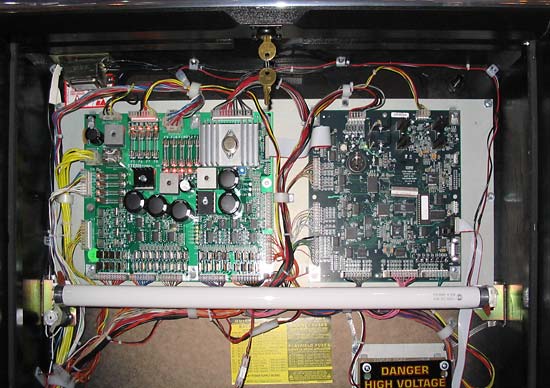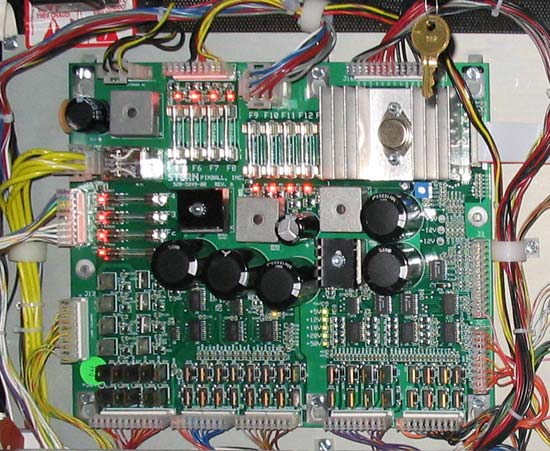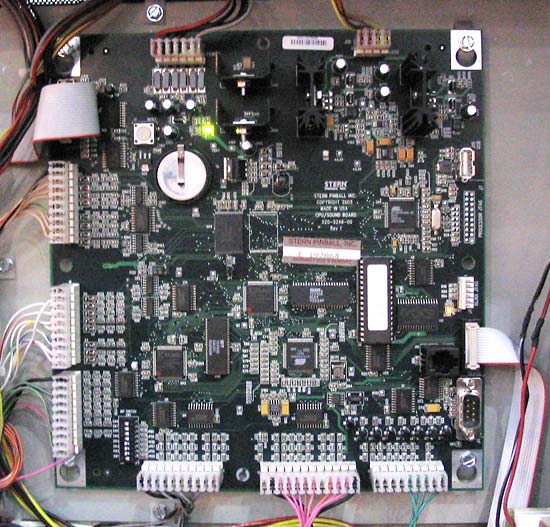|
|
|
WORLD POKER TOUR
|
|
So far we've look at the preliminary pictures and the test pictures of Stern's newest game, World Poker Tour. We've seen the cabinet, the backglass and the playfield, but there's one area we haven't looked at yet. This is a landmark game for Stern, because it is the first to feature their new hardware system. The Whitestar boardset has been with us (with a few tweaks and adjustments) for many many years now, so a replacement was long overdue and now at last we can take a look at it. So let's go inside the backbox.
It looks kinda empty but this is the new system - S.A.M. - named after Gary Stern's father Sam Stern. It's an acronym looking for a meaning, possibly Smoke and Mirrors, perhaps something else entirely. Even they don't know yet. There are two boards; on the left is the driver board and on the right is the processor board. There is also a third small board underneath them to provide the high voltages needed for the dot matrix display. We'll look at the two main boards starting with the driver board.
The major new features here are the individual LEDs for each fuse to show whether it is working or blown. No LED means the fuse has blown so you can easily check fuses now. There is also a column of yellow LEDs in the centre to show the presence of the five main voltage rails and they have clearly labeled test points too. There are some surface mount components but the main driver transistors are still discrete components so should be easily replaced if they fail. Coil diodes are back on the board so there's no chance to get the polarity wrong when replacing coils and they won't suffer from vibration breakage. The rest of the board is very much what we're used to. There's no use of switch mode power supplies so it's bridge rectifiers, capacitors and voltage regulators all the way. This should all be familiar to pinball techs. They do use new zero cross detection to switch coils which should produce more consistent results. If the driver board throws up few surprises, there are more to be found on the processor board.
This board not only provides the operating environment, it also provides all the sounds, music and dot matrix display effects. The DMD driver board previously mounted on the rear of the display has gone and its functionality is now incorporated into the new processor board. The first thing you'll notice is the lack of AA backup batteries. They've gone and are replaced by a single 3V lithium button cell. This should have a longer life and be less prone to leakage. Just above and to the left of the battery is the reset button. Again, there are some surface mount components but that's understandable because this is quite a complex board. The most exciting aspect is found over on the right side of the board:
Tested and approved memory sticks come from PNY Technologies (Attaché) and Lexar (JumpDrive) although many others will probably work too. There are more enhancements to the system too. In previous games, the dot matrix display was capable of showing black and three levels of orange. This was achieved by modulating each dots "on-time" so it was only illuminated for some of the time. Typically this was 100% for bright orange, 60% for medium orange and 40% for dim orange. But with the new system the number of levels has been increased from three to twelve. This will lead to much more realistic tones on the display as well as the ability to produce fades between and within effects. Something not easily done before. The dot matrix display itself remains unchanged. And ToPS is no more. Well, let me qualify that statement. The ToPS tournament system hardware display is no longer needed because the whole tournament system has been built into the game using the main display. You can still plug the extra ToPS display into the board using the jack provided but it's not a necessity any more. This is a move suggested by our friendly operator in his Comment column where he called for Stern to "make it easier for operators to run tournaments. Not through some $300 add-on but put it right there in the software and on the main display." Well, now they have. So, all good news so far. And the improvements continue with the new sound system. We don't have details of the memory available or sample rates used but it's clear to hear how the quality has improved with the new hardware. The use of real samples instead of synthesised sounds produces better music and provides much more flexibility. The only problem is, Stern have decided to keep the sound monaural. There's no surround sound, not even the return of stereo, just a single channel of sound. While operators may not worry whether it's 5.1 or 1.0 sound, the increased sales to home was thought to indicate an upgrade on the horizon despite the increase in development time. However it is not to be, despite others planning to put 4.1 surround sound in their upcoming games. There's also a change in the way the operator navigates the service menu. If you're used to the three button coin door (red, green and black) get ready to change to a new but strangely familiar four button system. Now it's Green (back or escape), Red1 (left or down), Red2 (right or up) and Black (enter or OK). It doesn't look like this will take much getting used to if you've owned games from another manufacturer. So that's what's inside all the new Stern games from World Poker Tour onwards. The USB interface and fuse LEDs were expected and necessary as was an overall increase in speed, memory and processing power. The integration of ToPS is a pleasant surprise as is the increased colour resolution. Don't expect to be able to upgrade your existing games though as the system is not backwardly compatible.
© Pinball News 2006 |




